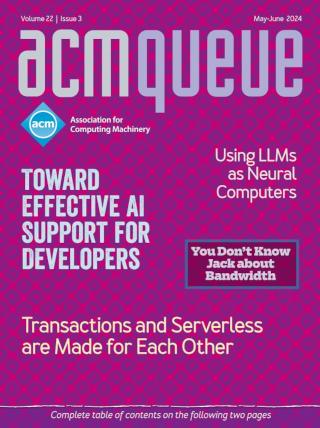
Triple-Parity RAID and Beyond:
As hard-drive capacities continue to outpace their throughput, the time has come for a new level of RAID.
How much longer will current RAID techniques persevere? The RAID levels were codified in the late 1980s; double-parity RAID, known as RAID-6, is the current standard for high-availability, space-efficient storage. The incredible growth of hard-drive capacities, however, could impose serious limitations on the reliability even of RAID-6 systems. Recent trends in hard drives show that triple-parity RAID must soon become pervasive. In 2005, Scientific American reported on Kryder’s law, which predicts that hard-drive density will double annually. While the rate of doubling has not quite maintained that pace, it has been close.
Some Rules and Restrictions May Apply:
An inquiry into contracts and the Next Big Thing
In many of our interactions with the outside world (solipsists can stop reading now, if indeed they ever started) we enter into contracts with diverse entities, some up front, some lurking below the surface. The commonly construed contractual theme is a mutual agreement where each party accepts certain costs and responsibilities, and in return can rely on certain benefits and rewards. Some sort of symmetry is implied, in that the rational parties favored by the economists (when they come out of their recessionary hiding holes) will weigh the positive and negative impacts of the agreement before "signing." I will put aside the notions of Hobbes, Rousseau, Rawls, and that crowd that in merely being born we enter into some form of social contract with the combined prevailing laws of nature, nurture, and parliamentary whoredom.
Standards Advice:
Easing the pain of implementing standards
My mother took language, both written and spoken, very seriously. The last thing I wanted to hear upon showing her an essay I was writing for school was, "Bring me the red pen." In those days I did not have a computer; all my assignments were written longhand or on a typewriter, so the red pen meant a total rewrite. She was a tough editor, but it was impossible to question the quality of her work or the passion that she brought to the writing process. All of the things Strunk and White have taught others throughout the years my mother taught me, on her own, with the benefit of only a high school education and a voracious appetite for reading.
Data in Flight:
How streaming SQL technology can help solve the Web 2.0 data crunch.
Web applications produce data at colossal rates, and those rates compound every year as the Web becomes more central to our lives. Other data sources such as environmental monitoring and location-based services are a rapidly expanding part of our day-to-day experience. Even as throughput is increasing, users and business owners expect to see their data with ever-decreasing latency. Advances in computer hardware (cheaper memory, cheaper disks, and more processing cores) are helping somewhat, but not enough to keep pace with the twin demands of rising throughput and decreasing latency.





